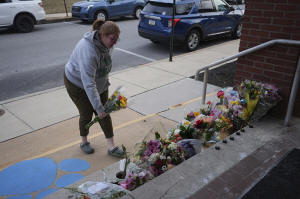Pennsylvania hostage-taking and shootout highlight rising violence
against US hospital workers
 Send a link to a friend
Send a link to a friend
 [February 24, 2025]
By MEAD GRUVER [February 24, 2025]
By MEAD GRUVER
A man who took hostages in a Pennsylvania hospital during a shooting
that killed a police officer and wounded five other people highlights
the rising violence against U.S. healthcare workers and the challenge of
protecting them.
Diogenes Archangel-Ortiz, 49, carried a pistol and zip ties into the
intensive care unit at UPMC Memorial Hospital in southern Pennsylvania's
York County and took staff members hostage Saturday before he was killed
in a shootout with police, officials said. The attack also left a
doctor, nurse, custodian and two other officers wounded.
Officers opened fire as Archangel-Ortiz held at gunpoint a female staff
member whose hands had been zip-tied, police said.
The man apparently intentionally targeted the hospital after he was in
contact with the intensive care unit earlier in the week for medical
care involving someone else, according to the York County district
attorney.
Such violence at hospitals is on the rise, often in emergency
departments but also maternity wards and intensive care units, hospital
security consultant Dick Sem said.
“Many people are more confrontational, quicker to become angry, quicker
to become threatening,” Sem said. “I interview thousands of nurses and
hear all the time about how they’re being abused every day.”

Archangel-Ortiz’s motives remained unclear but nurses report increasing
harassment from the public, especially following the coronavirus
pandemic, said Sem, former director of security and crisis management
for Waste Management and vice president at Pinkerton/Securitas.
In hospital attacks, unlike random mass shootings elsewhere, the shooter
is often targeting somebody, sometimes resentful about the care given a
relative who died, Sem noted.
“It tends to be someone who’s mad at somebody,” Sem said. “It might be a
domestic violence situation or employees, ex-employees. There’s all
kinds of variables.”
At WellSpan Health, a nearby hospital where some of the victims were
taken, Megan Foltz said she has been worried about violence since she
began working as a nurse nearly 20 years ago.
“In the critical care environment, of course there’s going to be
heightened emotions. People are losing loved ones. There can be gang
violence, domestic violence. Inebriated individuals,” Foltz said.
Besides the fear of being hurt themselves, nurses fear leaving their
patients unguarded.
“If you step away from a bedside to run, to hide, to keep safe, you’re
leaving your patient vulnerable,” she said.
[to top of second column]
|

Leah Fauth places flowers in front of the West York Police
Department after a police officer was killed responding to a
shooting at UPMC Memorial Hospital in York, Pa. on Saturday, Feb.
22, 2025. (AP Photo/Matt Rourke)
 Healthcare and social assistance
employees suffered almost three-quarters of nonfatal attacks on
workers in the private sector in 2021 and 2022 for a rate more than
five times the national average, according to the U.S. Bureau of
Labor Statistics.
Other recent attacks on U.S. healthcare workers
include:
— Last year, a man shot two corrections officers in the ambulance
bay of an Idaho hospital while freeing a white supremacist gang
member before he could be returned to prison. They were caught less
than two days later.
— In 2023, a gunman killed a security guard and wounded a hospital
worker in a Portland, Oregon, hospital's maternity unit before being
killed by police in a confrontation elsewhere. Also in 2023, a man
opened fire in a medical center waiting room in Atlanta, killing one
woman and wounding four.
— In 2022, a gunman killed his surgeon and three other people at a
Tulsa, Oklahoma, medical office because he blamed the doctor for his
continuing pain after an operation. Later that year, a man killed
two workers at a Dallas hospital while there to watch his child’s
birth.
The shooting is part of a wave of gun violence in recent years that
has swept through U.S. hospitals and medical centers, which have
struggled to adapt to the growing threats.
With rising violence, more hospitals are using metal detectors and
screening visitors for threats at hospital entrances including
emergency departments.
Many hospital workers say after an attack that they never expected
to be targeted.
Sem said training can be critical in helping medical staff identify
those who might become violent.

“More than half of these incidents I’m aware of showed some early
warning signs from early indicators that this person is problematic.
They’re threatening, they’re angry. And so that needs to be
reported. That needs to be managed,” he said.
"If nobody reports it, then you don't know until the gun appears."
___
Associated Press writer Chris Weber contributed to this report from
Los Angeles.
All contents © copyright 2025 Associated Press. All rights reserved |